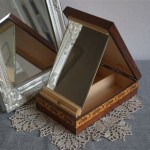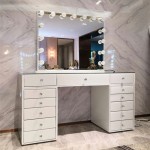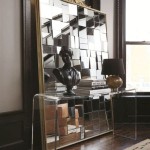The Enduring Allure of Mid-Century Modern Mirrors: A Vintage Perspective
Mid-Century Modern (MCM) design, spanning roughly from the mid-1940s to the late 1960s, continues to exert a powerful influence on contemporary aesthetics. Characterized by clean lines, organic shapes, and a focus on functionality, MCM pieces are highly sought after by design enthusiasts and collectors alike. Within this broad category, vintage mirrors from the Mid-Century era hold a special appeal, offering a unique blend of practical utility and artistic expression.
The popularity of these mirrors stems from a variety of factors, including their inherent timelessness, their ability to complement a wide range of interior styles, and the craftsmanship evident in their construction. Understanding the characteristics and historical context of vintage MCM mirrors is crucial for appreciating their value and incorporating them effectively into modern living spaces.
Defining Characteristics of Mid-Century Modern Mirrors
Several key features distinguish Mid-Century Modern mirrors from other eras. These characteristics reflect the broader design principles of the period, emphasizing simplicity, functionality, and the use of innovative materials. Recognizing these attributes is essential for identifying authentic vintage pieces and understanding their aesthetic significance.
One defining element is the emphasis on clean lines and geometric forms. Many MCM mirrors feature rectangular, square, or circular shapes, often with minimal ornamentation. This focus on geometric purity aligns with the era's rejection of elaborate Victorian and Art Deco styles. The frames, when present, are typically streamlined and unadorned, allowing the mirror itself to take center stage.
Another hallmark of MCM mirror design is the integration of natural materials. Wood, particularly teak, walnut, and birch, was frequently used for frames, reflecting the era's connection to nature and its appreciation for organic textures. These woods were often finished with a clear coat to showcase their natural grain and color variations. Other materials, such as metal (brass, chrome, or black iron) and occasionally even plastic laminate, were also incorporated, often in combination with wood, to create a sense of visual contrast and textural interest.
The use of unique shapes and unconventional designs is also a prevalent characteristic. While simple geometric forms were common, many MCM mirrors also featured asymmetrical shapes, starburst designs, or abstract patterns. These more adventurous designs reflected the era's experimentation with new forms and its embrace of artistic expression within functional objects. Some mirrors were even designed to be sculptural elements in their own right, blurring the line between art and utility.
Finally, the focus on functionality is an important aspect to consider. MCM mirrors were not merely decorative objects; they were designed to serve a practical purpose. Their size and placement were often carefully considered to maximize their effectiveness in reflecting light and creating a sense of spaciousness. Integrated features, such as built-in shelves or lighting, were sometimes incorporated to further enhance their functionality. This emphasis on practicality aligns with the broader MCM philosophy of designing objects that are both beautiful and useful.
Identifying Authentic Vintage Mid-Century Modern Mirrors
The growing popularity of Mid-Century Modern design has led to an increase in reproductions and replicas. Differentiating between authentic vintage pieces and modern imitations can be challenging but is crucial for collectors and those seeking to invest in genuine artifacts of the era. Several factors can assist in this identification process.
Examining the materials and construction techniques is a primary step. Authentic MCM mirrors typically exhibit high-quality craftsmanship and utilize materials consistent with the period. Look for solid wood frames, well-made joints, and evidence of meticulous attention to detail. Modern reproductions often use cheaper materials, such as particleboard or veneer, and may exhibit less precise construction. The type of glass used can also be an indicator; older mirrors may have a slightly different reflectivity or texture compared to modern glass.
Checking for maker's marks or labels is another valuable approach. Many MCM furniture and accessory manufacturers, such as Bassett, Broyhill, and Lane, included markings on their products. These markings can provide valuable information about the mirror's origin and date of manufacture. However, the absence of a maker's mark does not necessarily indicate that a mirror is not authentic, as some smaller workshops and independent designers did not always include markings. Researching known MCM manufacturers and their design styles can help in the identification process.
Assessing the mirror's condition and patina can also offer clues. While some wear and tear is to be expected in vintage pieces, excessive damage or alterations can detract from their value. Look for signs of age-appropriate wear, such as slight scratches or fading, which can contribute to the mirror's character. The patina of the materials, particularly wood and metal, can also be an indicator of age. Avoid mirrors that have been heavily refinished or altered, as this can diminish their authenticity and value.
Consulting with experts and conducting thorough research are essential for making informed decisions. Experienced antique dealers, vintage furniture specialists, and online resources dedicated to Mid-Century Modern design can provide valuable insights and guidance. Comparing the mirror to known authenticated examples and carefully examining its features can help in determining its authenticity.
Incorporating Vintage MCM Mirrors into Modern Interiors
Vintage Mid-Century Modern mirrors can seamlessly integrate into a variety of contemporary interior design schemes. Their versatility and timeless appeal make them ideal for adding a touch of character and sophistication to any space. Understanding how to effectively incorporate these mirrors into modern interiors is crucial for maximizing their aesthetic impact.
Consider the mirror's size and shape in relation to the surrounding space. A large, statement mirror can serve as a focal point in a living room or dining room, while a smaller, more subtle mirror can be used to enhance a hallway or bedroom. The shape of the mirror should complement the overall design of the room; for example, a circular mirror can soften the hard lines of a modern space, while a rectangular mirror can add a sense of structure and formality.
Pay attention to the mirror's placement and its ability to reflect light. Strategically placing a mirror opposite a window or near a light source can significantly enhance the brightness and spaciousness of a room. Avoid placing mirrors in areas where they will reflect clutter or create distracting glare. Consider the view that the mirror will reflect and ensure that it is aesthetically pleasing.
Mix and match MCM mirrors with other design elements. Vintage mirrors can be paired with both contemporary and traditional furniture and accessories. Combining a sleek MCM mirror with modern minimalist furniture can create a sophisticated and balanced aesthetic. Alternatively, pairing a vintage mirror with traditional furniture can add a touch of eclecticism and visual interest. Experiment with different combinations to find what works best for your personal style.
Use mirrors to create visual interest and depth. A gallery wall of MCM mirrors, in varying shapes and sizes, can add a unique and artistic touch to a room. Mirrors can also be used to create the illusion of greater depth in narrow hallways or small spaces. Consider using mirrors to highlight architectural features or to reflect interesting artwork or decorative objects.
Preserving and maintaining vintage MCM mirrors is essential for ensuring their longevity and beauty. Clean the mirror regularly with a soft, lint-free cloth and a gentle glass cleaner. Avoid using harsh chemicals or abrasive cleaners, as these can damage the mirror's surface or the frame. Protect the mirror from extreme temperatures and humidity, as these can cause warping or discoloration. Consider having the mirror professionally restored if it requires extensive repairs or refinishing. With proper care, vintage MCM mirrors can continue to enhance interior spaces for generations to come.

Mid Century Modern Mirrors

Vintage Mirrors Mid Century

Vintage Mid Century Italian Brass Mirror

Roper Mid Century Modern Gold Frame Decorative Wall Mirror West Mirrors

Stunning Mid Century Modern Mirror Sunburst Wall Starburst Handmade Solid Brass Large 120cms High X 80cms Wide

Vintage Mid Century Modern Solid Oak Wood Arched Wall Mirror Danish Style

Mid Century Mirrors Judy Frankel Antiques

Mid Century Mirrors That Will Look Great In A Retro Room With T

Mid Century Asymmetrical Wood Wall Mirror 14 Cm X 103 129 West Elm

Vintage Mid Century Mcm Style Turner Large Ornate Gold Tone Wall Mirror Frame








